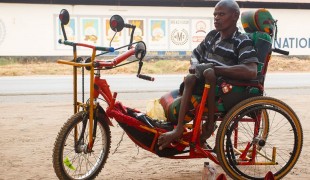- 3109
- 309
- 10
- 15
- 0
- Help Ukraine
About the solution
This solution was designed for quickie wheelchairs. These wheelchairs have a mechanism to rotate the armrest backwards and exit the wheelchair sideways but such mechanism can only be used with two hands. Upon assembling the product, it can be attached to the wheelchair and allows for one-handed usage of the mechanism. To do so, it locks the default system's handle in place once the handle is pressed and releases it again once a hook is pulled. This solution allows easier exit of this type of wheelchairs for one-handed users and can be adapted to other use cases.
The instructions section contains a description of how to recreate the solution's parts.
All files are published under the licence CC BY-NC 3.0. This means: the solution can be freely modified and redistributed for non-commercial usage.
https://vimeo.com/794614614
This solution shall not include mention to the use of drugs, chemicals or biologicals (including food); invasive devices; offensive, commercial or inherently dangerous content. This solution was not medically validated. Proceed with caution! If you have any doubts, please consult with a health professional.
-
-
240
-
0
-
2636

Collaborator James Leckey makes equipment to improve the quality of life and social inclusion of children with special needs
MOVING IN A WHEELCHAIR: Moving using a wheelchair.
BODY BALANCE: Maintaining body balance
STANDING UP: Standing up from a seated position
Playing
Neuromuscular Disorders
Assistive Daily Life Device (to help ADL)
Walking Aid (wheelchair/walker/crutches)
Assistive Technology access
5 Senses support devices: (glasses, hearing aids, headphones...)
Restoring mobility
Promoting self-management
Managing Neurological Disorders
Promoting inclusivity and social integration
Maintaining Balance and Mobility
Raise awareness
General and Family Medicine
Neurology
Orthopedics
Pediatrics
Physical Medicine and Rehabilitation
United States
-
-
-
393
-
0
-
4723

Man builds tricycles for disabled people
MOVING IN A WHEELCHAIR: Moving using a wheelchair.
CAREGIVING
Social interaction
Tendon and Ligaments Injuries
Assistive Daily Life Device (to help ADL)
Walking Aid (wheelchair/walker/crutches)
Restoring mobility
Promoting inclusivity and social integration
Maintaining Balance and Mobility
Raise awareness
General and Family Medicine
Neurology
Neurosurgery
Orthopedics
Physical Medicine and Rehabilitation
Rheumatology
Sports Medicine
Ghana
-
-
-
450
-
3
-
6732

Transfer board
-
 en
en